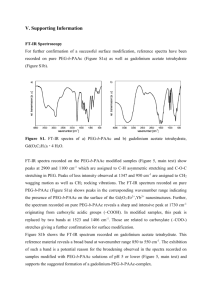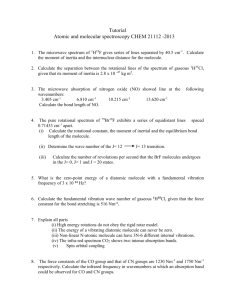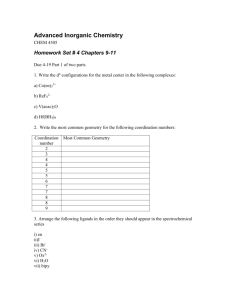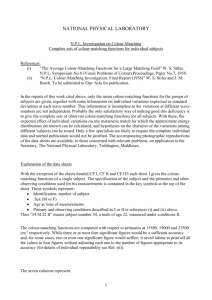Abstract
advertisement
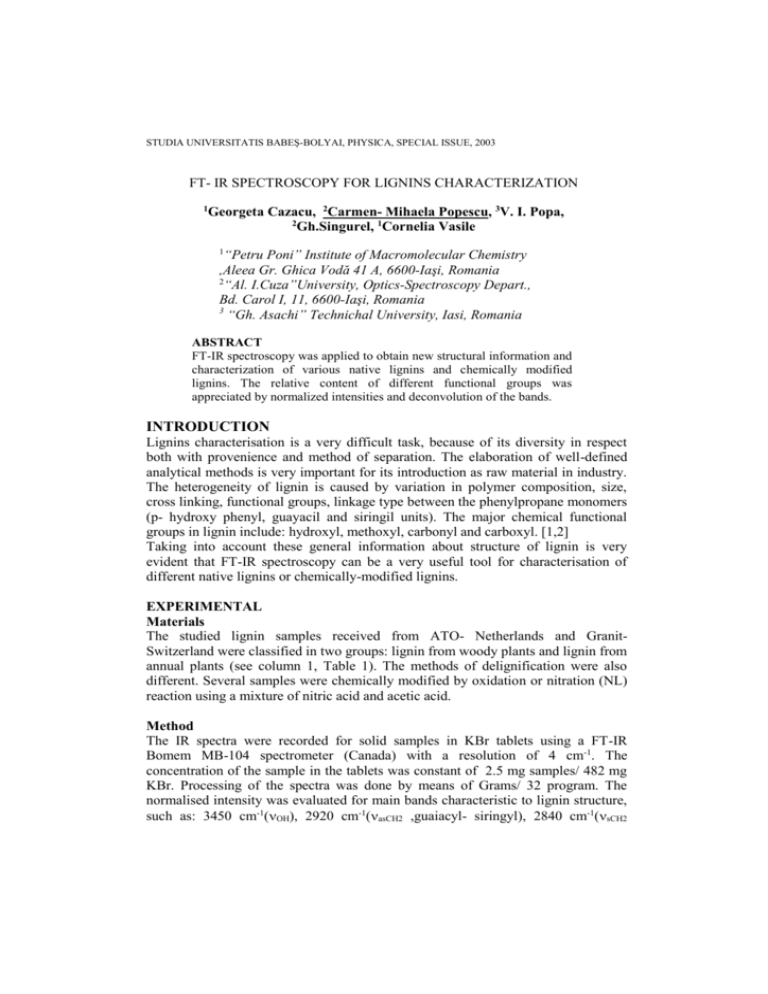
STUDIA UNIVERSITATIS BABEŞ-BOLYAI, PHYSICA, SPECIAL ISSUE, 2003 FT- IR SPECTROSCOPY FOR LIGNINS CHARACTERIZATION 1 Georgeta Cazacu, 2Carmen- Mihaela Popescu, 3V. I. Popa, 2 Gh.Singurel, 1Cornelia Vasile “Petru Poni” Institute of Macromolecular Chemistry ,Aleea Gr. Ghica Vodă 41 A, 6600-Iaşi, Romania 2 “Al. I.Cuza”University, Optics-Spectroscopy Depart., Bd. Carol I, 11, 6600-Iaşi, Romania 3 “Gh. Asachi” Technichal University, Iasi, Romania 1 ABSTRACT FT-IR spectroscopy was applied to obtain new structural information and characterization of various native lignins and chemically modified lignins. The relative content of different functional groups was appreciated by normalized intensities and deconvolution of the bands. INTRODUCTION Lignins characterisation is a very difficult task, because of its diversity in respect both with provenience and method of separation. The elaboration of well-defined analytical methods is very important for its introduction as raw material in industry. The heterogeneity of lignin is caused by variation in polymer composition, size, cross linking, functional groups, linkage type between the phenylpropane monomers (p- hydroxy phenyl, guayacil and siringil units). The major chemical functional groups in lignin include: hydroxyl, methoxyl, carbonyl and carboxyl. [1,2] Taking into account these general information about structure of lignin is very evident that FT-IR spectroscopy can be a very useful tool for characterisation of different native lignins or chemically-modified lignins. EXPERIMENTAL Materials The studied lignin samples received from ATO- Netherlands and GranitSwitzerland were classified in two groups: lignin from woody plants and lignin from annual plants (see column 1, Table 1). The methods of delignification were also different. Several samples were chemically modified by oxidation or nitration (NL) reaction using a mixture of nitric acid and acetic acid. Method The IR spectra were recorded for solid samples in KBr tablets using a FT-IR Bomem MB-104 spectrometer (Canada) with a resolution of 4 cm-1. The concentration of the sample in the tablets was constant of 2.5 mg samples/ 482 mg KBr. Processing of the spectra was done by means of Grams/ 32 program. The normalised intensity was evaluated for main bands characteristic to lignin structure, such as: 3450 cm-1(OH), 2920 cm-1(asCH2 ,guaiacyl- siringyl), 2840 cm-1(sCH2 POPESCU CARMEN MIHAELA ,guaiacyl- siringyl), 1730 cm-1(C=O non conjugated ketone and aromatic ester), 1658 cm-1(C=O aryl ketone p-substituted, guaiacyl), 1510 cm-1 and 1425 cm-1(C=C aromatic ring ,guaiacyl- siringyl), 1325 cm-1(s siringyl ring),1275 cm-1(s guaiacyl ring, asC-O-C),1220 cm-1(s siringyl ring),1030 cm-1 (C-H guaiacyl aromatic ring and C-OH primary alcohol), and 860 cm-1 (=CH aromatic ring ,guaiacyl- siringyl).[3] Shoulders and complex bands were deconvoluted for a good assessment. RESULTS AND DISCUSSION The spectral data of the studied lignins are given in table 1. It can be remarked that the strongest hydrogen bonds are present in lignin from Pine and Curan lignin and also in lignosulfonates whose 3450 cm-1 band is very strong. The bands at 1275 cm-1and 1220 cm-1 (1330 cm-1) (Fig.1a,b,c) assigned to guaiacyl, respectively siringyl ring increase/decrease in the series studied of lignin from woody plants. a. b. c. Figure.1. Variation of the normalised intensities of the bands at 1275cm-1(a), 1220 cm-1(b) and 1330 cm-1(c) The lignin from annual plants have much complex IR spectra, the bonds at 2840 cm1 and 1325 cm-1 are stronger than those of woody plants (see Table 1). The oxidation leads to the destruction of aromatic ring because of introduction of carbonyl and carboxyl groups. The bands at 1275 cm-1(s guaiacyl ring) (Fig.2a), 1510 cm-1 (C=C aromatic ring ,guaiacyl- siringyl)(Fig.2b)and 1700cm-1 (C=O non conjugated ketone) (Fig.2c) decrease in the series studied of lignin from flax. The presence of the -NO2 and -ONO2 groups was possible to be evidenced only often deconvolution (Fig.3b-d), they appearing in spectrum as very weak peaks (880 cm-1), or shoulders (1277 cm-1, 1544 cm-1), or overlapped with other bonds (1614 cm-1)(Fig. 3a). Therefore FT-IR spectroscopy can be successfully used in the characterisation of complex molecules as lignin, having in view that its structure depends on the raw material, extraction/ separation procedure and chemical modification. FT- IR SPECTROSCOPY FOR LIGNINS CHARACTERIZATION Lignins from woody plants Hardwood organosolv Aspen wood/ SE Softwood, kraft (1) Softwood, kraft (2) Softwood SF HpH Softwood SF LpH Softwood L.Sf. (white) Softwood L.Sf. Pine, kraft Curan wood Alcell/ wood 3.08 m m m __ m s m w vw m w vvw 3.17 s m m __ __ m m w vw m w __ 3.25 vs m __ __ w m v w w w w vvw 3.25 vs __ __ vw m m w w w w vvw 3.59 m __ __ vvw m vw w w w w __ 3.25 m m __ __ w s w vv w vv w vv w __ m m m vvw 3.34 m __ vw m m vw m s vvw __ __ vw m w m v w __ m 3.59 vv s m m s s __ 3.77 3.68 3.25 m m m m w m m w m __ vvw __ w w m m w s vw vvw m vw __ w m w vw m w m m w m vw vvw vw Flax SF (1) 3.34 s vs s __ m m vvw m m m vvw Flax SF(2) 3.51 s vs s __ m m w m m m vw Flax oxidized PF 3035/ Flax Straw BPD/ Straw Sisal 3.42 s vs m m m m vw w m w vvw 3.42 s s s __ m m vw w m w vvw 2.99 3.08 3.17 vs s s m m m w m m m m w m __ __ m m m w w w v w v w v w vv w vw vv w m m w m m w __ __ vvw Sisal/ Soda pulping PF 3074/ Hemp Hemp 3.25 s s m m s m w w m m vvw 3.42 s s m m m vw vw w w m vv w vv w w w w vvw 3.42 vs s m w m w vw vw vw vw vvw Jute 2.99 s s m m m m w vw m m vvw Abaca 2.65 vs m m __ __ s m v w v w w __ s w w __ __ __ __ __ __ __ __ vs s s m __ __ m m __ m __ m __ __ __ vw __ __ __ __ Lignins from annual fibre crops Nitrolignins NL A NL B NL C NL D 2.75 3.15 3.71 4.24 m m m m vw m w m vvw w vvw m __ s __ m vs s vs __ vs - very strong, s - strong, m - medium, w - weak, vw - very weak, NL A-fraction precipitated with dioxane, NL B-fraction precipitated with ethyl ether/ dichlorethane , NL C-fraction precipitated with water and NL D- residue guaiacil - siringil […] 1030cm-1 C-H guayacil aromatic ring and -1 C-OH primary 866cm =CH alcohol aromatic ring C=C aromatic ring guayacil - siringil 1325cm-1 s siringil ring and C-O 1275cm-1 s guayacil ring as C-O-C aromatic 1220cm ester -1 s siringil ring C=C aromatic ring guayacil - siringil -1 1425cm C=O aryl ketone p-substituted guayacil-1 1510cm 1730cm-1 C=O non conjugated ketone and aromatic 1658cm-1ester 2840cm-1 s CH2 guayacil siringil 2920cm-1 as CH2 guayacil siringil Names EH (the energy of hydrogen bond) 3450 cm-1 OH Table 1. FT-IR results for lignins of various origins and for chemically modified lignins POPESCU CARMEN MIHAELA a. b. c. Figure.2. Variation of the normalised intensity of the bands at 1275cm-1(a), 1510 cm-1(b) and 1700 cm-1(c) a. b. c. d. Figure.3. FT-IR spectra of nitrolignin(a) and deconvolutions for 1900-1450 cm-1(b), 14501100 cm-1(c) and 910-840 cm-1(d) regions of the spectra References 1 .R.J . A.Go s se li n k, A. Ab äc her li, H .S e mk e, R. Mal h erb e, P .K ä up er a nd J .E.G. va n D a m , Characterisation of sulfur-free lignins frm alkaline pulping of annual fibre crops, Fifth International Forum of ILI, Bordeaux France, September 7, 2000 2. A. Ab äc h er l i , New lignins from agricultural plants, Idem. 3.A.B e r mel lo , M.d el V a lle, U.Or ea a nd L. R. C a rb allo , Characterisation by IR spectromerty of lignins of three eucaliptus species,Intern. J. of Polym. Mat., 51: 557-566p, 2002


